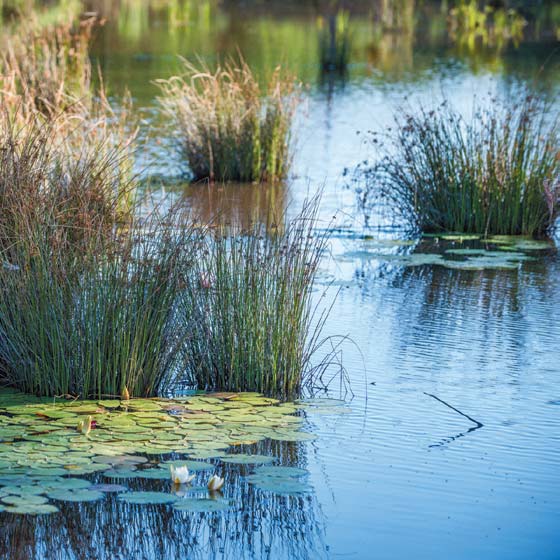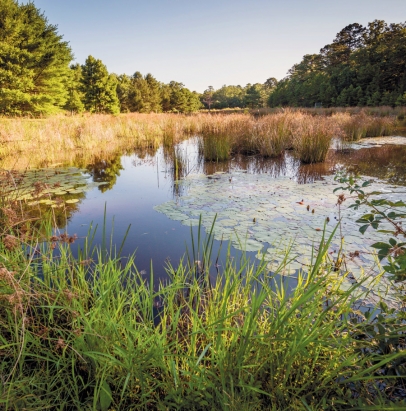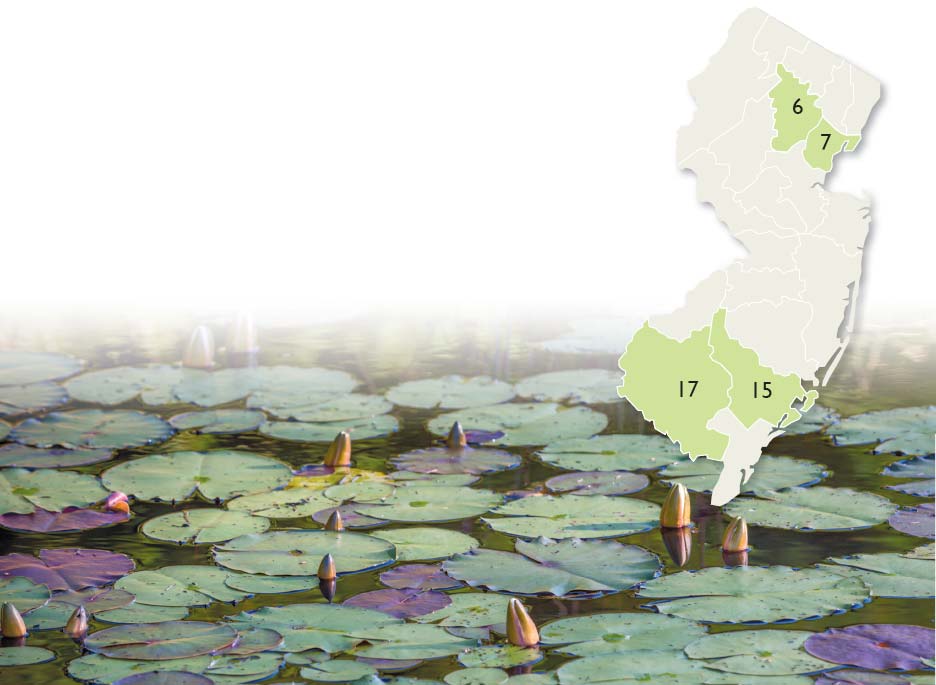Not a Drop to Spare
Pinelands Preservation Alliance urges us to “save the source”
In a state that boasts 1,792 miles of coastline when you count bays, offshore islands, sounds, rivers and creeks, it’s strange to think of water as a scarce commodity. This is ever more so the case after a summer marked by frequent rain. Yet water here has always required careful management. It’s why the New Jersey Water Supply Management Act was passed in 1981.
In the legislation, our water resources are cast as “public assets of the State held in trust for its citizens.” They are “essential to the health, safety, economic welfare, recreational and aesthetic enjoyment, and general welfare, of the people of New Jersey.”
Yet even then, our supply was deemed insufficient to provide an “adequate margin of safety.” It’s why we have a state Water Supply Plan, which after sitting untouched since 1996 was finally updated in draft form in May of 2017.
The new data reveal cause for concern. Four of our 20 watersheds are currently stressed, with 11 more in the danger zone should water be drawn from the system at maximum permitted levels.
That’s an issue that resonates in the Pine Barrens, where there is fear that the Comprehensive Management Plan designed to balance human and ecological needs won’t be enough to keep its water resources from being siphoned off as other regions face deficits.
All told, the pristine, shallow aquifer
supplies groundwater to the entirety of
the Pine Barrens and about a million
South Jersey residents. It is also the irrigation
source for more than 200,000
acres of South Jersey farmland.
A Fragile Aquifer
Fed by the 17-trillion-gallon Kirkwood-Cohansey Aquifer, the waterways of the Pines are a boon to everything from agriculture to recreation. Fresh rivers, tannic and cedar-steeped, are fed by the Cohansey layer of the aquifer and stream out toward the coast. They refresh estuaries and support an array of native plants and animals along the way. Cranberry farmers flood bogs with aquifer-sourced water each fall, harvests conducted in shades of crimson. Atlantic City’s famed Formica Bros. Bakery even credits it as the “secret” behind their Italian bread.
“The key thing for me is how fragile it is,” reflects Jason Howell, Stewardship Coordinator for the Pinelands Preservation Alliance (PPA). Short drops in water levels can have severe impacts on rare species from the Pine Barrens tree frog to orchids. In areas where there has been too much local withdrawal, habitat disruption has already been seen.
Over the long term, South Jersey’s human occupants also have cause for concern. “This aquifer is a source of drinking water for many people,” PPA’s Assistant Executive Director Jaclyn Rhoads adds. “If we don’t put policies in place, what gets sacrificed?”
It’s a connection between man and water that goes back generations.
Early settlers harnessed Pinelands water to run sawmills. In the heyday of iron, circa the mid-18th century, it powered huge forges and fortunes. In the late 19th century, water attracted industrialist Joseph Wharton to the Pines. With an eye on the liquid treasure bound up in the aquifer, he snapped up land, aiming to pipe the waters into Philadelphia. The state stepped in with legislation prohibiting cross-state water export in 1884. Between 1954 and 1955, 96,000 acres of that tract were purchased by the state for $3 million, eventually becoming Wharton State Forest.
Their primary interest, writes Arthur Dudley Pierce in Iron in the Pines (Rutgers University Press, 1957; reprint 1965), was in the watershed.
In that sense, water might be thought of as the region’s savior. Had Wharton succeeded, who knows what the Pinelands would look like today, to say nothing of the water supply for South Jersey. All told, the pristine, shallow aquifer supplies groundwater to the entirety of the Pine Barrens and about a million South Jersey residents. It is also the irrigation source for more than 200,000 acres of South-Jersey farmland, and for a number of commercial and industrial enterprises. That makes it a critical natural supply.
This is ever more apparent with the May release of the state Department of Environmental Protection’s draft New Jersey Water Supply Plan 2017–2022.
A Plan Without a Plan?
First, the good news: “Generally, New Jersey has sufficient water available to meet needs into the foreseeable future,” the report states. But mind the word “generally.” Environmentally minded organizations, including the team at PPA and the New Jersey Highlands Coalition—both of which have regionally specific master plans that include water sustainability thresholds—see serious cause for concern. In part, this is because sufficiency is reliant on:
• Efficient conservation and reuse
• Greater public education
• Remediation of deteriorating infrastructure
• Better interconnectedness of water systems and resource optimization
• Full funding for monitoring
All good things. The catch? Members of the Alliance find that the draft document, though technically rich, is scant on detailed action plans. During public meetings held in July, that sentiment echoed. Representing the New Jersey chapter of the Sierra Club, Toni Granato noted an absence of climate-change calculations in the analysis. Some, however, made the point that DEP planning has to be backed by legislation for anything substantive to happen.
Key policy initiatives outlined in the report include an effort to “encourage the development of new and expanded sources of supply.” With the state population set to expand from roughly 9 million to somewhere between 9.7 million and 10.4 million by 2034, according to models from the New Jersey Department of Workforce and Labor Development, that means system stresses will continue. Usage projections, however, only look to 2020. Moreover, water-use permits given to corporate and agricultural entities last 10 years.
It is with this in mind that the Pinelands Preservation Alliance is aiming to raise awareness regarding the need for smart water management statewide. Together with the New Jersey Highlands Coalition, they formed SaveH2ONJ.org, which includes the American Littoral Society, the Association of New Jersey Environmental Commissions, the New Jersey League of Conservation Voters and the New Jersey Conservation Foundation.
PPA also launched a yearlong “Save the Source” campaign, which focuses on threats to the Kirkwood-Cohansey. A companion website includes an interactive tool where visitors can see the effects of overuse and pollutants on their local system.
PPA’s goal is to encourage conservation-minded policy regarding the Kirkwood-Cohansey, make the threats tangible to a non-specialist audience and offer opportunities for action. Specifically, the Alliance is advocating for regulatory thresholds to allocation requests. This means only allowing new or increased withdrawals if there is not an alternative source; the creation of protective thresholds at a regional watershed level; and the adoption of local protective thresholds that safeguard wetlands. Additionally, the Alliance wants to see conservation measures and monitoring for all new or increased allocations, and better-quality monitoring and remediation planning.
The centerpiece of the campaign is a video series directed by PPA’s Jason Howell, a cinematographer known for his Syria-focused documentary, After Spring. Each video showcases a local whose livelihood or lifestyle depends on the water. This includes farmers like Jennifer LaMonica of B&B Farms CSA in Little Egg Harbor, area homeowners and brewer Jay Chapman from Pinelands Brewing Company, who credits the aquifer with the quality of his beer.
“Our raw water is perfect for making beer,” he says. “It’s as pure as can be, and the end result is going to be cleaner beer.” (See page 30, “Proud to be Pinelands Brewing Company”)
Yet that purity requires vigilance.

“What we’re seeing in this
water supply plan is that
really, the majority of the
state is tapped out.”
—Jaclyn Rhoads,
assistant executive director, Pinelands Preservation Alliance
Stressed Water Supply
According to the draft report, four in 20 of the state’s Water Management Areas (WMAs) are stressed, with 11 more in the danger zone should withdrawals reach permitted levels. (According to the draft plan, “40% of agricultural users use less than 10% of their approved allocations, and 20% used none.) This includes two with a footprint in the southern portion of the Pines: The Great Egg Harbor WMA and the Maurice, Salem and Cohansey WMA. By 2020, they are projected to run at a 25-million- and 70-milliongallon daily deficit, making them the most stressed in the state. The Mullica WMA, which covers a greater portion of the region, is projected to run at a modest 7-million-gallon daily surplus.
Yet what happens as population and development pressures grow? Will it be Wharton all over again, just on a local level?
“For a number of years, we have been calling for the release of the water-supply master plan to drive changes in policies through the Pinelands Commission that would not only look at available water supply for human consumption, but also for protection of ecological communities,” says Rhoads of the PPA.
In 2012, the PPA pulled together a Science Policy Forum that drew on state-funded research conducted by the US Geological Survey and the Pinelands Commission. It looked at water levels and drawdown impacts in the Kirkwood-Cohansey, and established thresholds for responsible management. Save the Source brings that message home. “Once you get people connected and understanding ‘Oh, I’m a farmer,’ or ‘I’m a fisherman,’ they feel more engaged,” Rhoads says. The hope is that informed residents will be inspired to rally for the aquifer’s long-term protection. “What we’re seeing in this water supply plan is that really, the majority of the state is tapped out,” Rhoads says.
Based on current water availability and projected demands, the expectation is that decisions will need to be made. Exactly what those are, however, remains unclear.
Currently, much of the Pinelands—including the water supply—is managed as part of the comprehensive plan overseen by the Pinelands Commission. However, the Kirkwood-Cohansey expands beyond its boundaries, meaning that parts are less protected and vulnerable to overuse. At the public meeting in July, Richard Bizub, the PPA’s director for water programs, cited concern that a provision of the 1981 Water Supply Management Act allows for the export of water from the region to an area 10 miles beyond its bounds. Future demands there could stress Pinelands resources. Given ongoing debates over pipelines and development, even the future within the region requires vigilance.
In February, the Pinelands Commission approved the South Jersey Gas Pipeline in spite of significant public protest, and another, the New Jersey Natural Gas Pipeline, is under consideration. While it remains to be seen what happens with those projects, PPA sees this shift as troubling. “A lot of people seem to write off the Pinelands, saying oh, they have a plan, they have the federal and state legislation that protected it,” Rhoads continues. “The pipeline is a very clear example of why the region can still be at risk, why there are still threats looming. Water doesn’t follow political boundaries.”
While the situation requires careful attention, there is some good news to report. Per-capita water use in New Jersey decreased from 155 gallons to 125 gallons per day between 1990 and 2015, attributable in part to efficient plumbing and appliances. Moreover, New Jersey collectively used just under 750 billion gallons in 2015, down from 1.1 trillion gallons in the early 2000s.
And there have been efforts to explore other practical alternatives. Cape May County residents know what it’s like when water is scarce. In the 1990s, demand outstripped supply, with salt-water intrusion forcing the water authority to go farther and farther inland to find potable sources. Eventually, city officials rolled the dice and built a $5 million desalination plant—which paid off, allowing them to filter salt from water sources closer to the shore. Based on the most recent data, supply in that watershed is now sufficient, if not by a grand margin. State Department of Environmental Protection projections for 2020 estimate that about 6 million of 21 million available gallons will remain accessible on a daily basis, which means the supply is adequate to meet local needs. That’s not a huge overage, but it means the system is in check.
Save the Source
Those interested in taking action can visit the Save the Source website. From volunteer clean-up projects to letter-writing and home conservation, every drop saved is a sign of progress. “We can actually do this in a sustainable way, but we have to make a concerted effort to do it,” Howell says. “The reality exists and it needs to be addressed.”
A good place to begin is in your own backyard. On average, 58% of the water lost to evaporation, transpiration or incorporation between 2011 and 2015 was from a potable source. In other words, when you water your lawn on ultra-hot summer days, it greatly exacerbates stress on the state’s water supplies. By landscaping with native plants, less water is needed—not to mention fewer water-threatening fertilizers. Inside the house, small changes can also have a great impact. According to the state DEP, something as simple as turning off the water while brushing your teeth can save up to 11,680 annual gallons. Other easy tasks, like only running the washing machine when full, can save 10,534 gallons per year.
Find other ways to conserve our water at nj.gov/dep/watersupply/conserve.htm and on the Save the Source website.
SAVE THE SOURCE
609.859.8860 x21 savethesource.org
NJ’s Stressed Watersheds
4 in 20 of the state’s Water Management Areas (WMAs) are currently strsed.
6–Upper and Middle Passaic, Whippany and Rockaway
7–Arthur Kill
15–Great Egg Harbor
17–Maurice, Salem and Cohansey
WATER FOR LIFE: THE NATURE CONSERVANCY
In addition to exploring SavetheSource.org and SaveH2oNJ.org, another place to connect with efforts to preserve clean water in the Garden State is The Nature Conservancy of New Jersey. Their mission is “to protect the land and waters on which all of life depends.”
- Recognizing the impact of development on everything from flooding to clean water supplies, the group is leveraging nature as a solution, including the development of rain gardens throughout the state that keep pollutants out of our waterways.
- In 2016, as part of efforts to restore the Paulins Kill watershed, the group and its partners planted 8,600 native trees and shrubs in vital fl oodplains.
- They are working with the City of Newark to conduct a feasibility study focused on potential improvements to storm-water management.
- Coastal programs emphasize the need for resilience in the face of sea-level rise, including the creation of oyster-reef breakwaters near Gandy’s Beach and Money Island on the Delaware Bay.
Throughout the year, the organization offers numerous educational and volunteer opportunities. To learn more, or to get involved, visit: nature.org/ourinitiatives/regions/ northamerica/unitedstates/newjersey. Or follow along on Instagram at @nature_nj.






